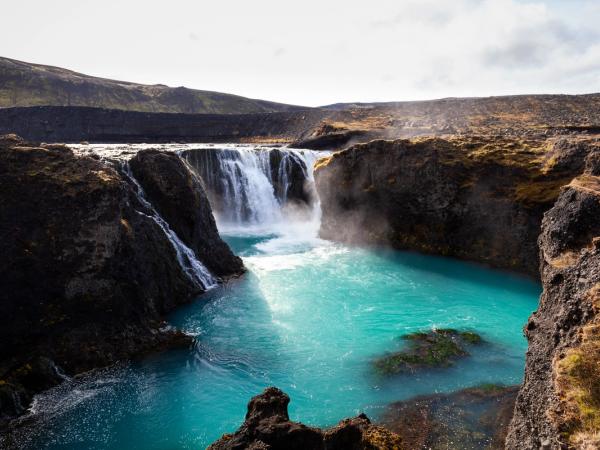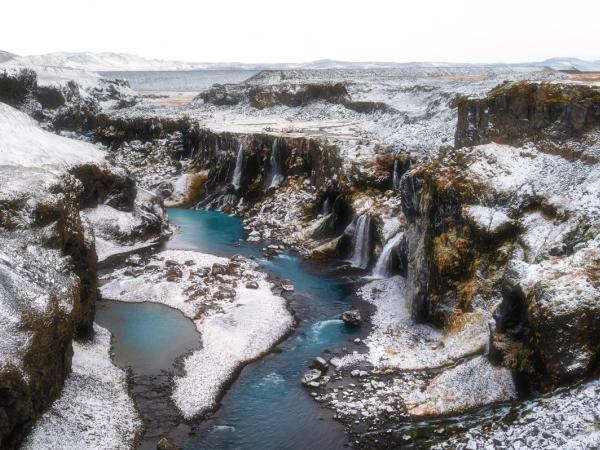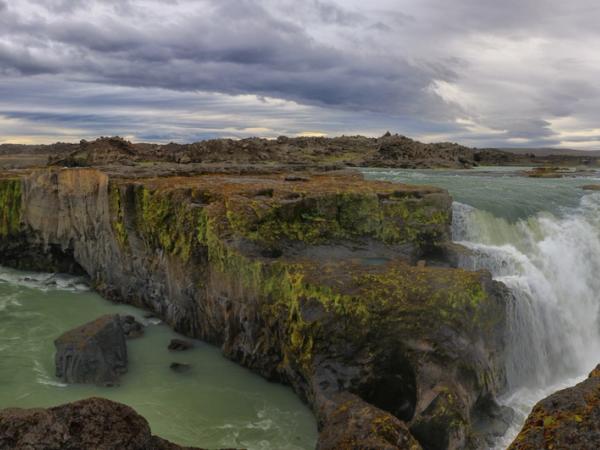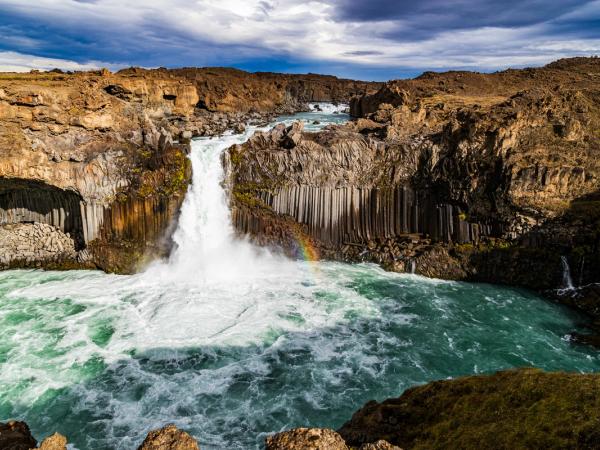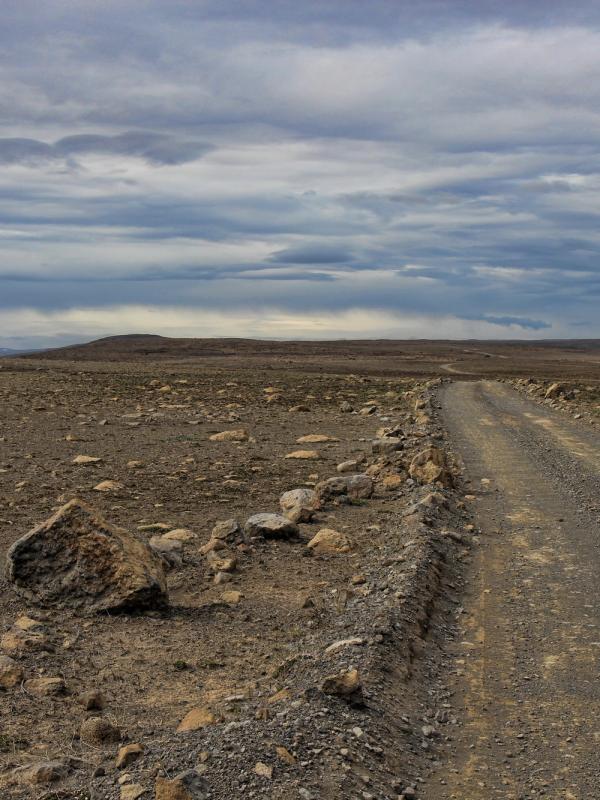
The Sprengisandur Route
The Sprengisandur Route, or F26, is a legendary road that traverses the heart of Iceland's Highland region. This remote and desolate expanse offers a truly unique and awe-inspiring landscape for those with a 4x4 campervan and an adventure of a lifetime.
From the barren moonscape to the majestic mountains and glaciers, the Sprengisandur Route will leave any adventurer in awe. In this comprehensive guide, we will explore every aspect of this remarkable route, from its history and highlights to practical tips for a successful and enjoyable trip.
Introduction to F26 - Sprengisandur
The Sprengisandur Route, designated as Route F26, is a remote and rugged road that winds its way through the heart of Iceland's interior. Stretching for approximately 196km (122 miles), it’s a challenging drive through Iceland’s most untouched and desolate landscapes. The lingering image travelers will have of Sprengisandur is one of endless expanses of grey volcanic desert, distant glaciers and mountains, and a sense of isolation. The stark and barren landscape is both mesmerizing and intimidating.
Sprengisandur is accessible only during the summer and by well-equipped 4x4 vehicles, as it involves crossing several unbridged rivers and rough terrain. It’s a challenging and adventurous road, but the reward is stunning views of the glaciers, mountains, and utterly barren landscapes.
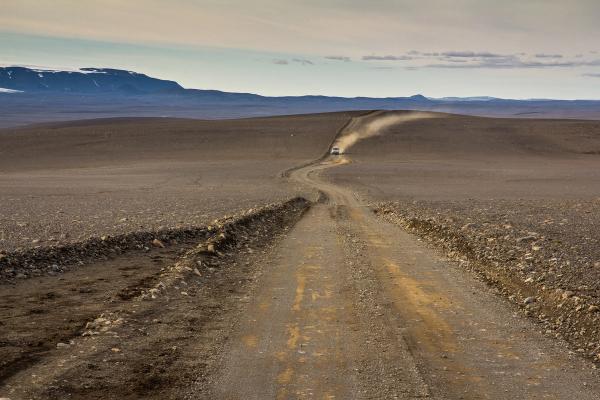
You might also be interested in our Guide to F35 – the Kjolur Route in Iceland.
History and Legends of the Sprengisandur Route
Sprengisandur is one of the ancient routes that connected the north and south of Iceland and was used a lot to travel between the two regions (especially during the time when the Althing gathered at Thingvellir National Park). However, it was also the most desolate and dangerous route the first settlers could take. Crossing a vast volcanic desert for hundreds of kilometers, there was no shelter along the way and little to no food for the travelers and their horses. This is where the name Sprengisandur originates: it is derived from the Icelandic noun sandur (sand) and sprengja (to ride a horse to death). The early travelers taking this route needed to ride their horses as fast as possible, nearly driving them to death, to safely cross the volcanic interior and reach the inhabited southern region before their food and water ran out.
Like a lot of other spooky places in Iceland, Sprengisandur was also a place of folklore and mystery, as it was believed to be haunted by various supernatural beings, such as ghosts, giants, elves, and outlaws. Some of the most famous outlaws who hid in Sprengisandur were Fjalla-Eyvindur and his wife Halla, who lived on the southern border of the area in the 18th century. They were notorious for stealing sheep and horses and for escaping the authorities for many years.
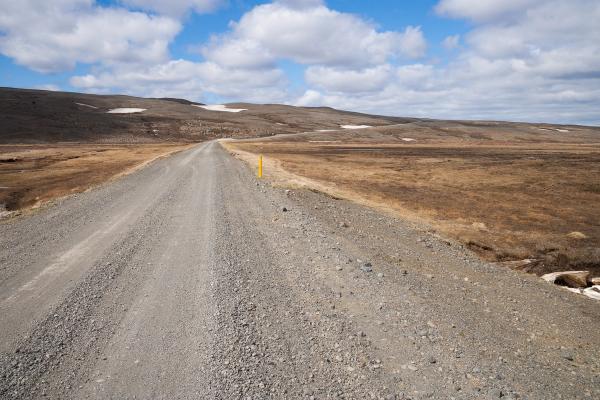
Driving the Sprengisandur Route in Iceland
In this section, you’ll find all the information you need to know if you plan to tackle the Sprengisandur Route. We’ll talk about the different 4x4 campervans we have for you to choose from, what campsites are available along the route, and the major river crossings you’ll need to tackle.
It’s important to note again here that the route is passable only with a 4x4 campervan and only during the summer months when the conditions are favorable, and the road is officially open.
Choosing the Right Vehicle for the Sprengisandur Route: 4x4 Campervans
When embarking on a journey along the Sprengisandur Route, choosing the right vehicle is crucial for a safe and successful trip. Our range of 4x4 campervans is designed to be able to handle the F-Roads of Iceland, offering the necessary power and capabilities to tackle the challenging terrain and river crossings.
That said, we recommend taking one of our bigger 4x4 campervans along this route, such as our brand new Go 4x4 Cruiser Camper, which comes with the snorkel that allows it to cross deeper rivers. The main reason is that there’s a medium to large river crossing, and it can be quite deep if there has been recent rain or glacial melt. If that’s the case, our Go 4x4 Top Camper, made using the popular Dacia Duster 4x4 vehicle, might not have enough clearance to safely cross the river without flooding the engine. If the conditions are normal, it will make it, but if you’re in one of these campers and there has been recent rainfall, you might need to backtrack.
However, any of our other 4x4 campervans are more than ready to handle this river crossing. We’ll discuss the campsites available below in more detail.
Campsites Along the Sprengisandur Route
Splitting the drive along the Sprengisandur Route into two days is a popular choice for those with a campervan, allowing you to really immerse yourself in this desolate part of the country.
There is only one campsite along the route, though, the Nýidalur Mountain Hut. Here, you’ll find warm showers, a fully-equipped kitchen, hut wardens, and national park rangers on hand to give you advice for the rest of the route.
River Crossings on the Sprengisandur Route
The Sprengisandur Route presents several river crossings that require careful navigation and preparation. The most significant river crossing is the Hagakvislar River, located just to the north of the Nýidalur mountain hut. This ford can be challenging, especially during periods of heavy rain or glacial meltwater. It is crucial to follow the river crossing guidelines and stay within the designated crossing area. As we’ve already mentioned, this river can be dangerous to cross for smaller 4x4 campers, like our GO 4x4 Top Camper (i.e., the Dacia Duster 4x4), if there have been recent rains during a period of warmer weather, which brings with it more glacial melt. It’s still possible to cross the river with this campervan, but it’s advisable to discuss the crossing with the wardens and rangers at the Nýidalur Mountain Hut before any attempt.
The other two river crossings are usually easy to cross; there’s one small river and one medium river, but neither usually presents a problem.
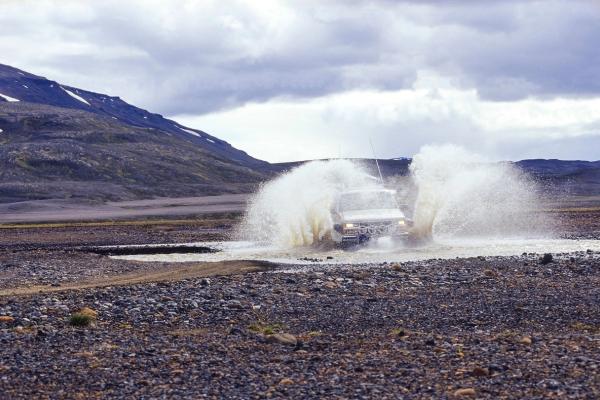
Weather and Safety Considerations for F26 in Iceland
Weather conditions in the Icelandic Highlands can be unpredictable and harsh, even during the summer months. The F26 is known to close due to the weather, but mostly because of the Hagakvislar River swelling to dangerous levels for 4x4s.
It’s essential to check the weather forecast (https://en.vedur.is/) and road conditions before embarking on the Sprengisandur Route. Additionally, it is recommended to carry essential safety equipment, including a first aid kit and extra food and water supplies. Traveling in a convoy is advisable if possible; it’s also helpful when crossing the rivers to have another 4x4 ready to help.
Highlights and Attractions along the F26
There are only a few big stops to make along the F26. The biggest attraction of driving this route is the stark beauty and remoteness of traversing a large sub-arctic desert, the vast expanse of grey sand, stones, and rocks, with glaciers and mountains on the horizon.
With that being said, there are a few cool stops you might want to make on the F26:
Sigoldufoss & Sigöldugljúfur
The first little detour you might want to make from F26 is to see Sigoldufoss waterfall and Sigöldugljúfur Canyon. Sigoldufoss, the waterfall, was formed when the glacial river Tungnaá was diverted to the nearby power plant. The remaining spring water flows over a six-meter-high cliff and forms a turquoise pool at the bottom. The waterfall is surrounded by green vegetation and contrasts with the barren landscape of the highlands. Sigöldugljúfur, on the other hand, is a canyon that is filled with dozens of small waterfalls. It’s also known as the Valley of Tears because of the way the waterfalls look like tears running down the canyon walls.
To visit both, you’ll want to turn onto F208 (which continues down to Landmannalaugar). After a short drive, you’ll see the power plant. After this, a lefthand turn takes you essentially right next to the waterfall. To get to Sigöldugljúfur you’ll need to drive further south along F208. A similar side road takes you to a parking area, but this road is very rough, and a lot of people instead park on the side of F208 and walk the 15–20 minutes to the canyon.
Búðarhálsfoss (Dynkur) Waterfall
Búðarhálsfoss, also known as Dynkur, is a spectacular waterfall in the highlands of Iceland. It is located in the river Þjórsá, the longest river in the country, and has a height of about 38 meters. The waterfall consists of several steps and cascades, with the water flowing through a narrow chasm on the northern side of the valley, adding to the drama. This is definitely one of the largest waterfalls you’ll find in the country and also one of the most remote.
To visit Búðarhálsfoss, you must tackle a rough, unmarked track that branches off the F26. It’s not marked on most maps, but you can follow the rough directions in our map below, which will lead you to the parking area. There are a few signs along the way as well to keep you moving in the right direction. The drive takes about an hour from F26, and then from the parking area, it’ll take around 15-20 minutes to hike to the waterfall. You can also hike along the canyon rim and explore more of the area.
Nýidalur
To the southeast of the route is the mountain hut of Nýidalur, a popular resting place for travelers and the only campsite on the Sprengisandur Route. Green valleys and hills surround it and contrast the bleak landscape of the highlands. Nýidalur is also a good base for hiking, and there’s a guided hike with the ranger during summer, which occurs each evening at 20:30.
Hrafnabjargafoss & Aldeyjarfoss Waterfalls
Hrafnabjargafoss is another beautiful waterfall that is located further north on the F26 road. It is less visited than Aldeyjarfoss below, but equally impressive. The waterfall consists of three cascades that drop into a deep canyon, and you can easily spend some time here exploring the canyon rim and taking in the views.
Further north still is Aldeyjarfoss, a waterfall growing in popularity. It’s 20 meters high and plunges into a turquoise pool, but what makes this waterfall special is the black basalt columns that surround the water. The contrast between the white water and dark rocks is striking. The waterfall is a 10-minute walk from the parking lot, and you can enjoy the view from the upper or lower riverbank.
Tips and Recommendations for a Successful Journey
To ensure a successful and enjoyable journey along the Sprengisandur Route, here are some additional tips and recommendations:
- Plan your itinerary and allow for ample time to explore and appreciate the landscapes.
- Pack essential supplies, including food, water, warm clothing, and a comprehensive map.
- Familiarize yourself with the river crossing guidelines and follow them diligently.
- Check road conditions and weather forecasts regularly for any updates or changes.
- Respect the environment and leave no trace of your presence.
- Be prepared for limited cell phone coverage and lack of facilities along the route.
F26 – Adventure in The Icelandic Highlands
Embarking on an adventure along the Sprengisandur Route is a truly extraordinary experience through Iceland’s most desolate and captivating landscapes. From the desolate expanse of the sub-Arctic desert to the powerful river crossings and hidden gems along the way, this route offers a unique and unforgettable experience for those willing to venture into the heart of the Icelandic Highlands. With careful planning, the right vehicle, and a sense of adventure, the Sprengisandur Route will be an Icelandic adventure you won’t forget.

